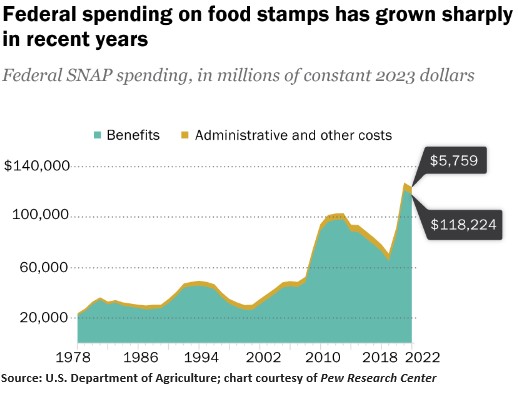I have always been the main cook in the Halbert family. My Mom taught me to cook at an early age, and I enjoy it. As such, I am the main grocery shopper in the family. While our kids are grown and no longer live with us, I still shop and cook for the two of us just about every day.
I typically shop for food at the largest grocery store chain in Texas. One thing I’ve noticed when in the checkout lane over the last few years is that more and more people are using “food stamps” to pay for their groceries. What I didn’t know until just recently is that increased use of food stamps causes grocery prices to rise faster.
I must admit this would have never crossed my mind were it not for a recent article I read on the explosion of food stamp usage in the last few years and how that has affected food prices. Why would it matter to prices, I wondered, whether more people are using food stamps versus credit cards or cash? Turns out, it does. Let’s look at some numbers.
The government’s original “Food Stamp Program” first began in the late 1930s. The original program was halted in 1943, followed by several pilot programs over the next couple of decades. The goal of the program was to provide food-purchasing assistance for low- and no-income people to help them maintain adequate nutrition and health.
President John F. Kennedy is credited with formalizing the food stamp program, and President Lyndon Johnson later signed the “Food Stamp Act of 1964” in August of that year. The program has expanded over the years under both Republican and Democrat presidents.
In 2008, the program’s name was changed to the Supplemental Nutrition Assistance Program (SNAP) as we know it today. The amount of SNAP benefits received by a household depends on its size, income and expenses.
The USDA and other sources cite studies which show that consumer demand for food/groceries increases commensurately with increased issuance of food stamps. And food stamp usage has exploded in recent years, especially since the Great Recession in 2008-09, as we’ll see below.
Overall spending on SNAP more than doubled between 2019 and 2022, according to findings from the Foundation for Government Accountability (FGA). It went from $4.5 billion in 2019 to $11 billion in 2022, the study found.
So, How Many Americans Use Food Stamps?
The numbers vary from month to month, but in April 2023, the most recent month with available figures, 41.9 million people in 22.2 million households received SNAP benefits. That translates to 12.5% of the total US population.
The program operates in all 50 states, the District of Columbia, Guam and the Virgin Islands. A separate nutrition assistance program covers Puerto Rico, American Samoa and the Northern Mariana Islands.
A big reason for the huge price increase in recent years is the fact that President Biden’s Department of Agriculture rolled out revised nutritional standards for federal food benefits in 2021 which expanded SNAP by roughly 25% from pre-COVID pandemic levels.
And here is the result: The Biden administration’s massive expansion of food stamp benefits is linked to at least a 15% rise in grocery prices, the FGA’s new study reported last week. 15% or more – let that one soak in.
A recent World Bank study concluded that food prices increase by one percent for every 12.5% increase in food stamp spending. With US food stamp spending expanding by almost 2½ times since 2019, it is no wonder food prices have soared.
Food prices on average are expected to increase 5.8% in 2023, according to the US Department of Agriculture (USDA). It’s a slower pace compared to 2022 but still significantly higher than “historical-average rates,” the department said.
It is impossible to know whether food stamp issuance by the government will continue to increase at the rate expected this year, but I believe it is quite safe to predict that food stamp use will continue to rise over time. It is also safe to assume that food prices will continue to rise as well – regardless of who is in the White House or which party controls Congress.
But at least we now know there is a direct correlation between food stamp issuance and food/grocery prices.


Sorry, comments are closed for this post.